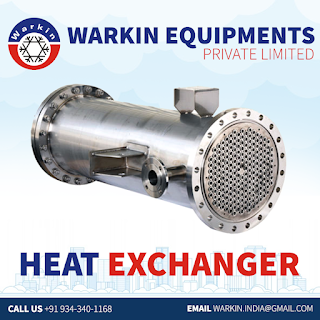Cleaning and maintenance tips for your heat exchanger!
We, WARKIN EQUIPMENTS PVT LTD is a prominent heat exchanger manufacturers in India. Heat exchangers are designed to maximize heat transfer from one gas or liquid to another through processing; thus, decreased heat exchanger output due to fouling or aging leads to increased operational and energy costs to compensate for temperature variations. Fouling and debris diminish heat exchanger efficiency and, if left uncontrolled, can cause industrial equipment and processes to fail. Shutdowns caused by heat exchanger failure may be highly expensive. And it costs several times the cost of even the most complicated cleaning methods.
Heat exchanger cleaning, on the other hand, will enhance performance and
save money if done correctly. They must be cleaned regularly to maintain high
efficiency and minimize interruptions in processing.
Cleaning and
maintenance of heat exchanger:
- Ultra
High-Pressure Jetting: It is both
effective&ecologically safe. Ultra-high pressure water jetting should
be one of the first options for any heat exchanger cleaning program. This
technique will also assist to reduce cleaning and maintenance expenses by
eliminating the requirement for hazardous chemical disposal services which
may do more damage to the exchanger by weakening or degrading the
material, leading to increased costs. This technique is the preferable
cleanup method in virtually every circumstance, even if it has been for
use in conjunction with another technique such as drilling.
- Keep a
Schedule: Routine
maintenance should be done regularly. Cleaning on a constant schedule will
keep deposits and silt from building up to dangerous levels that might
necessitate a plant closure. Cleaning and inspection processes should be
combined to verify that equipment is fully functioning and fulfills
regulatory requirements.
- Go bare metal: When cleaning heat exchangers, all deposits&silt
must be removed. Also, the pipes must be clean down to the bare metal.
Failure to remove all fouling will not provide the desired advantages and
will lower the return on investment in maintenance. Additionally, keeping
the insides of the pipes polished will enhance liquid throughput.
- Polymer deposits may be exceedingly difficult to remove. Use extra
caution while removing them using common instruments like chisels&hammers
to avoid harming the heat exchanger itself. The thicker they are, the
longer it takes to remove polymer deposits. All this highlights the
significance of periodic cleaning and maintenance.
Finally, these suggestions will help your firm cut costs and downtime.
It also guarantees that your heat exchangers are clean to the point where they
improve profitability. We are a heat exchanger suppliers in India. When
you have concerns regarding appropriate heat exchanger care, need replacement
components, or are ready for a new unit, contact Warkin. We would be happy to
help.



Comments
Post a Comment